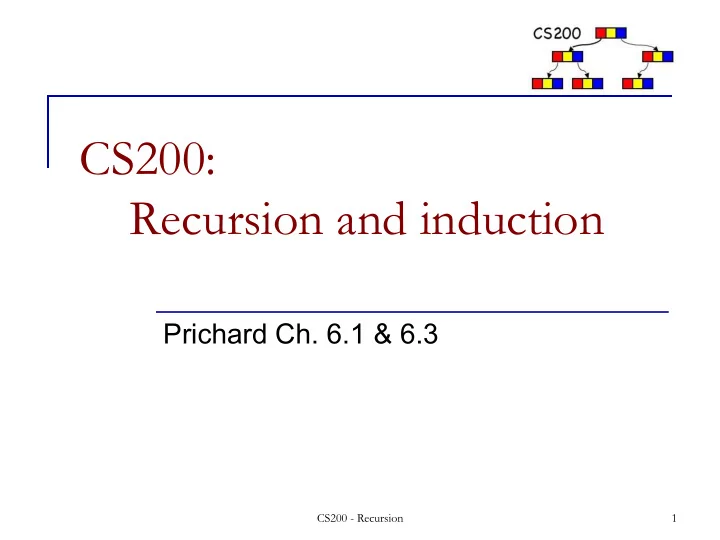

CS200: Recursion and induction Prichard Ch. 6.1 & 6.3 CS200 - Recursion 1
CS200 - Recursion 2
Backtracking n Problem solving technique that involves moves: guesses at a solution. n Depth First Search: in case of failure retrace steps and try a new move in a state with still unexplored guesses Think of it as walking through a tree shaped state space. 3 guesses here 2 guesses in each state here leaf states can fail (F) or succeed (S) CS200 - Recursion 3
F F F S F F F F F S F F F F F S F F F F F S F F F F F S F F F F F S F F F F F S F F Found! CS200 - Recursion 4
Depth First Search n Looking for a path out of the maze n Strategy: q Prioritize directions: right, straight or left. q At a dead end “backtrack” and try a different direction ^ n Recursive solution? CS200 - Recursion 5
The Eight Queens Problem Place 8 Queens! No queen can attack any other queens. CS200 - Recursion 6
Solution with recursion and backtracking placeQueen (in currColumn:integer) � if ( currColumn > 8) { The problem is solved � } else { � while (unconsidered squares exist in currColumn and the � problem is unsolved) { � Determine if the next square is safe. � if (such a square exists){ � � place a queen in the square � � placeQueens(currColumn+1) // try next column � if (no queen safe in currColumn+1) { � � � remove queen from currColumn � � � � try the next square in that column � } � } � } � } � CS200 - Recursion 7
Example 1 2 3 4 5 6 7 8 Q Q Q 4 Q 2 Q 5 3 1 CS200 - Recursion 8
Hit ‘Dead End’ 1 2 3 4 5 6 7 8 Q Q Q 8 4 2 Q 5 3 1 Q CS200 - Recursion 9
Backtrack 1 2 3 4 5 6 7 8 Q If you go Q on, this will fail Q 8 2 and you 2 need to 7 Q back 5 track 3 to col 4 10 Q 1 CS200 - Recursion
Backtrack: an 8 queens solution Q The only symmetric one Q Q There are 11 more “fundamental” solutions Q Q see: Q wikipedia.org/wiki/ Q Eight_queens_puzzle Q CS200 - Recursion 11
Questions n What is the maximum depth of the runt time stack for 8 Queens? n How big could the call tree get? CS200 - Recursion 12
Recursion n Specifies a solution to one or more base cases n Then demonstrates how to derive the solution to a problem of an arbitrary size q From solutions to smaller sized problems. CS200 - Recursion 13
Correctness of the Recursive Factorial Method Specification of the problem (e.g., Mathematical definition, SW requirements) Algorithm (e.g., pseudo code) Does your algorithm satisfy the specification of the problem? CS200 - Recursion 14
Correctness of the Recursive Factorial Method Definition of Factorial factorial(n) = n (n – 1) (n – 2) … 1 for any integer n > 0 factorial(0) = 1 Definition of method fact(N) 1: fact (in n: integer): integer � 2: if (n is 0) { � 3: return 1 � 4: } else { � 5: return n* fact(n-1) � 6: } � CS200 - Recursion 15
Inductive proof fact computes the factorial of its argument. Basis step: fact(0) = 1 Inductive Step: Show that for an arbitrary positive integer k , if fact(k) returns k ! , then fact(k+ 1 ) returns (k+ 1 ) ! do it do it CS200 - Recursion 16
The Towers of Hanoi Example n Move pile of disks from source to destination n Only one disk may be moved at a time. n No disk may be placed on top of a smaller disk. CS200 - Recursion 17
States in the Towers of Hanoi Source Destination Spare CS200 - Recursion 18
Recursive Solution // pegs are numbers, via is computed // number of moves are counted // empty base case public void hanoi(int n, int from, int to){ if (n>0) { int via = 6 - from - to; hanoi(n-1,from, via); System. out.println("move disk " + n + " from " + from + " to " + to); hanoi(n-1,via,to); } } let’s run it CS200 - Recursion 19
Cost of Towers of Hanoi n How many moves does hanoi(n) make? n from the recursive code: moves(1) = 1 moves(N) = moves(N-1)+1+moves(N-1) (if N>1) n By inspection, we can infer that a closed form formula for the number of moves: moves(N) = 2 N - 1 (for all N>=1) n Can we prove it? CS200 - Recursion 20
Proof n Basis Step q Show that the property is true for N = 1 . 2 1 - 1 = 1 , which is consistent with the recurrence relation’s specification that moves( 1 ) = 1 n Inductive Step q Property is true for an arbitrary k è property is true for k+1 q Assume that the property is true for N = k moves(k) = 2 k -1 q Show that the property is true for N = k + 1 q Do it, do it CS200 - Recursion 21
Proof – cont. n moves(k+1) = 2 * moves(k) + 1 = 2 * ( 2 k - 1 ) + 1 = 2* 2 k - 2 + 1 = 2 k+1 -1 Therefore the inductive proof is complete. CS200 - Recursion 22
0+1+2…+n = n(n+1)/2 n=0,1,2…. base: 0 = 0*1/2=0 Check step: assume: 0+1+2 … +k = k(k+1)/2 show that 0+1+2 … +k+ (k+1) = (k+1)(k+2)/2 0+1+2 … +k+ (k+1) = k(k+1)/2 + (k+1) = k(k+1)/2 + 2(k+1)/2 = k(k+1)/2 + 2(k+1)/2 = (k+2)(k+1)/2 = (k+1)(k+2)/2 Check CS200 - Recursion 23
Recommend
More recommend